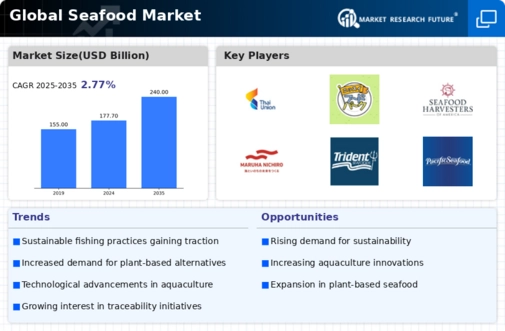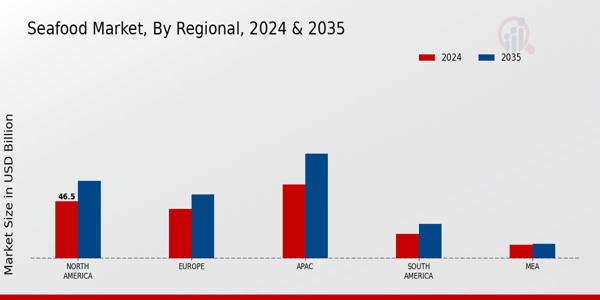Fish
Shellfish
Caviar
Seaweed
Supermarkets
Online Retail
Fish Markets
Food Service
Fresh
Frozen
Canned
Processed
Household
Commercial
Food Processing
North America
Europe
South America
Asia Pacific
Middle East and Africa
North America Outlook (USD Billion, 2019-2035)
North America Seafood Market by Product Type
Fish
Shellfish
Caviar
Seaweed
North America Seafood Market by Distribution Channel Type
Supermarkets
Online Retail
Fish Markets
Food Service
North America Seafood Market by Form Type
Fresh
Frozen
Canned
Processed
North America Seafood Market by End Use Type
Household
Commercial
Food Processing
North America Seafood Market by Regional Type
US
Canada
US Outlook (USD Billion, 2019-2035)
US Seafood Market by Product Type
Fish
Shellfish
Caviar
Seaweed
US Seafood Market by Distribution Channel Type
Supermarkets
Online Retail
Fish Markets
Food Service
US Seafood Market by Form Type
Fresh
Frozen
Canned
Processed
US Seafood Market by End Use Type
Household
Commercial
Food Processing
CANADA Outlook (USD Billion, 2019-2035)
CANADA Seafood Market by Product Type
Fish
Shellfish
Caviar
Seaweed
CANADA Seafood Market by Distribution Channel Type
Supermarkets
Online Retail
Fish Markets
Food Service
CANADA Seafood Market by Form Type
Fresh
Frozen
Canned
Processed
CANADA Seafood Market by End Use Type
Household
Commercial
Food Processing
Europe Outlook (USD Billion, 2019-2035)
Europe Seafood Market by Product Type
Fish
Shellfish
Caviar
Seaweed
Europe Seafood Market by Distribution Channel Type
Supermarkets
Online Retail
Fish Markets
Food Service
Europe Seafood Market by Form Type
Fresh
Frozen
Canned
Processed
Europe Seafood Market by End Use Type
Household
Commercial
Food Processing
Europe Seafood Market by Regional Type
Germany
UK
France
Russia
Italy
Spain
Rest of Europe
GERMANY Outlook (USD Billion, 2019-2035)
GERMANY Seafood Market by Product Type
Fish
Shellfish
Caviar
Seaweed
GERMANY Seafood Market by Distribution Channel Type
Supermarkets
Online Retail
Fish Markets
Food Service
GERMANY Seafood Market by Form Type
Fresh
Frozen
Canned
Processed
GERMANY Seafood Market by End Use Type
Household
Commercial
Food Processing
UK Outlook (USD Billion, 2019-2035)
UK Seafood Market by Product Type
Fish
Shellfish
Caviar
Seaweed
UK Seafood Market by Distribution Channel Type
Supermarkets
Online Retail
Fish Markets
Food Service
UK Seafood Market by Form Type
Fresh
Frozen
Canned
Processed
UK Seafood Market by End Use Type
Household
Commercial
Food Processing
FRANCE Outlook (USD Billion, 2019-2035)
FRANCE Seafood Market by Product Type
Fish
Shellfish
Caviar
Seaweed
FRANCE Seafood Market by Distribution Channel Type
Supermarkets
Online Retail
Fish Markets
Food Service
FRANCE Seafood Market by Form Type
Fresh
Frozen
Canned
Processed
FRANCE Seafood Market by End Use Type
Household
Commercial
Food Processing
RUSSIA Outlook (USD Billion, 2019-2035)
RUSSIA Seafood Market by Product Type
Fish
Shellfish
Caviar
Seaweed
RUSSIA Seafood Market by Distribution Channel Type
Supermarkets
Online Retail
Fish Markets
Food Service
RUSSIA Seafood Market by Form Type
Fresh
Frozen
Canned
Processed
RUSSIA Seafood Market by End Use Type
Household
Commercial
Food Processing
ITALY Outlook (USD Billion, 2019-2035)
ITALY Seafood Market by Product Type
Fish
Shellfish
Caviar
Seaweed
ITALY Seafood Market by Distribution Channel Type
Supermarkets
Online Retail
Fish Markets
Food Service
ITALY Seafood Market by Form Type
Fresh
Frozen
Canned
Processed
ITALY Seafood Market by End Use Type
Household
Commercial
Food Processing
SPAIN Outlook (USD Billion, 2019-2035)
SPAIN Seafood Market by Product Type
Fish
Shellfish
Caviar
Seaweed
SPAIN Seafood Market by Distribution Channel Type
Supermarkets
Online Retail
Fish Markets
Food Service
SPAIN Seafood Market by Form Type
Fresh
Frozen
Canned
Processed
SPAIN Seafood Market by End Use Type
Household
Commercial
Food Processing
REST OF EUROPE Outlook (USD Billion, 2019-2035)
REST OF EUROPE Seafood Market by Product Type
Fish
Shellfish
Caviar
Seaweed
REST OF EUROPE Seafood Market by Distribution Channel Type
Supermarkets
Online Retail
Fish Markets
Food Service
REST OF EUROPE Seafood Market by Form Type
Fresh
Frozen
Canned
Processed
REST OF EUROPE Seafood Market by End Use Type
Household
Commercial
Food Processing
APAC Outlook (USD Billion, 2019-2035)
APAC Seafood Market by Product Type
Fish
Shellfish
Caviar
Seaweed
APAC Seafood Market by Distribution Channel Type
Supermarkets
Online Retail
Fish Markets
Food Service
APAC Seafood Market by Form Type
Fresh
Frozen
Canned
Processed
APAC Seafood Market by End Use Type
Household
Commercial
Food Processing
APAC Seafood Market by Regional Type
China
India
Japan
South Korea
Malaysia
Thailand
Indonesia
Rest of APAC
CHINA Outlook (USD Billion, 2019-2035)
CHINA Seafood Market by Product Type
Fish
Shellfish
Caviar
Seaweed
CHINA Seafood Market by Distribution Channel Type
Supermarkets
Online Retail
Fish Markets
Food Service
CHINA Seafood Market by Form Type
Fresh
Frozen
Canned
Processed
CHINA Seafood Market by End Use Type
Household
Commercial
Food Processing
INDIA Outlook (USD Billion, 2019-2035)
INDIA Seafood Market by Product Type
Fish
Shellfish
Caviar
Seaweed
INDIA Seafood Market by Distribution Channel Type
Supermarkets
Online Retail
Fish Markets
Food Service
INDIA Seafood Market by Form Type
Fresh
Frozen
Canned
Processed
INDIA Seafood Market by End Use Type
Household
Commercial
Food Processing
JAPAN Outlook (USD Billion, 2019-2035)
JAPAN Seafood Market by Product Type
Fish
Shellfish
Caviar
Seaweed
JAPAN Seafood Market by Distribution Channel Type
Supermarkets
Online Retail
Fish Markets
Food Service
JAPAN Seafood Market by Form Type
Fresh
Frozen
Canned
Processed
JAPAN Seafood Market by End Use Type
Household
Commercial
Food Processing
SOUTH KOREA Outlook (USD Billion, 2019-2035)
SOUTH KOREA Seafood Market by Product Type
Fish
Shellfish
Caviar
Seaweed
SOUTH KOREA Seafood Market by Distribution Channel Type
Supermarkets
Online Retail
Fish Markets
Food Service
SOUTH KOREA Seafood Market by Form Type
Fresh
Frozen
Canned
Processed
SOUTH KOREA Seafood Market by End Use Type
Household
Commercial
Food Processing
MALAYSIA Outlook (USD Billion, 2019-2035)
MALAYSIA Seafood Market by Product Type
Fish
Shellfish
Caviar
Seaweed
MALAYSIA Seafood Market by Distribution Channel Type
Supermarkets
Online Retail
Fish Markets
Food Service
MALAYSIA Seafood Market by Form Type
Fresh
Frozen
Canned
Processed
MALAYSIA Seafood Market by End Use Type
Household
Commercial
Food Processing
THAILAND Outlook (USD Billion, 2019-2035)
THAILAND Seafood Market by Product Type
Fish
Shellfish
Caviar
Seaweed
THAILAND Seafood Market by Distribution Channel Type
Supermarkets
Online Retail
Fish Markets
Food Service
THAILAND Seafood Market by Form Type
Fresh
Frozen
Canned
Processed
THAILAND Seafood Market by End Use Type
Household
Commercial
Food Processing
INDONESIA Outlook (USD Billion, 2019-2035)
INDONESIA Seafood Market by Product Type
Fish
Shellfish
Caviar
Seaweed
INDONESIA Seafood Market by Distribution Channel Type
Supermarkets
Online Retail
Fish Markets
Food Service
INDONESIA Seafood Market by Form Type
Fresh
Frozen
Canned
Processed
INDONESIA Seafood Market by End Use Type
Household
Commercial
Food Processing
REST OF APAC Outlook (USD Billion, 2019-2035)
REST OF APAC Seafood Market by Product Type
Fish
Shellfish
Caviar
Seaweed
REST OF APAC Seafood Market by Distribution Channel Type
Supermarkets
Online Retail
Fish Markets
Food Service
REST OF APAC Seafood Market by Form Type
Fresh
Frozen
Canned
Processed
REST OF APAC Seafood Market by End Use Type
Household
Commercial
Food Processing
South America Outlook (USD Billion, 2019-2035)
South America Seafood Market by Product Type
Fish
Shellfish
Caviar
Seaweed
South America Seafood Market by Distribution Channel Type
Supermarkets
Online Retail
Fish Markets
Food Service
South America Seafood Market by Form Type
Fresh
Frozen
Canned
Processed
South America Seafood Market by End Use Type
Household
Commercial
Food Processing
South America Seafood Market by Regional Type
Brazil
Mexico
Argentina
Rest of South America
BRAZIL Outlook (USD Billion, 2019-2035)
BRAZIL Seafood Market by Product Type
Fish
Shellfish
Caviar
Seaweed
BRAZIL Seafood Market by Distribution Channel Type
Supermarkets
Online Retail
Fish Markets
Food Service
BRAZIL Seafood Market by Form Type
Fresh
Frozen
Canned
Processed
BRAZIL Seafood Market by End Use Type
Household
Commercial
Food Processing
MEXICO Outlook (USD Billion, 2019-2035)
MEXICO Seafood Market by Product Type
Fish
Shellfish
Caviar
Seaweed
MEXICO Seafood Market by Distribution Channel Type
Supermarkets
Online Retail
Fish Markets
Food Service
MEXICO Seafood Market by Form Type
Fresh
Frozen
Canned
Processed
MEXICO Seafood Market by End Use Type
Household
Commercial
Food Processing
ARGENTINA Outlook (USD Billion, 2019-2035)
ARGENTINA Seafood Market by Product Type
Fish
Shellfish
Caviar
Seaweed
ARGENTINA Seafood Market by Distribution Channel Type
Supermarkets
Online Retail
Fish Markets
Food Service
ARGENTINA Seafood Market by Form Type
Fresh
Frozen
Canned
Processed
ARGENTINA Seafood Market by End Use Type
Household
Commercial
Food Processing
REST OF SOUTH AMERICA Outlook (USD Billion, 2019-2035)
REST OF SOUTH AMERICA Seafood Market by Product Type
Fish
Shellfish
Caviar
Seaweed
REST OF SOUTH AMERICA Seafood Market by Distribution Channel Type
Supermarkets
Online Retail
Fish Markets
Food Service
REST OF SOUTH AMERICA Seafood Market by Form Type
Fresh
Frozen
Canned
Processed
REST OF SOUTH AMERICA Seafood Market by End Use Type
Household
Commercial
Food Processing
MEA Outlook (USD Billion, 2019-2035)
MEA Seafood Market by Product Type
Fish
Shellfish
Caviar
Seaweed
MEA Seafood Market by Distribution Channel Type
Supermarkets
Online Retail
Fish Markets
Food Service
MEA Seafood Market by Form Type
Fresh
Frozen
Canned
Processed
MEA Seafood Market by End Use Type
Household
Commercial
Food Processing
MEA Seafood Market by Regional Type
GCC Countries
South Africa
Rest of MEA
GCC COUNTRIES Outlook (USD Billion, 2019-2035)
GCC COUNTRIES Seafood Market by Product Type
Fish
Shellfish
Caviar
Seaweed
GCC COUNTRIES Seafood Market by Distribution Channel Type
Supermarkets
Online Retail
Fish Markets
Food Service
GCC COUNTRIES Seafood Market by Form Type
Fresh
Frozen
Canned
Processed
GCC COUNTRIES Seafood Market by End Use Type
Household
Commercial
Food Processing
SOUTH AFRICA Outlook (USD Billion, 2019-2035)
SOUTH AFRICA Seafood Market by Product Type
Fish
Shellfish
Caviar
Seaweed
SOUTH AFRICA Seafood Market by Distribution Channel Type
Supermarkets
Online Retail
Fish Markets
Food Service
SOUTH AFRICA Seafood Market by Form Type
Fresh
Frozen
Canned
Processed
SOUTH AFRICA Seafood Market by End Use Type
Household
Commercial
Food Processing
REST OF MEA Outlook (USD Billion, 2019-2035)
REST OF MEA Seafood Market by Product Type
Fish
Shellfish
Caviar
Seaweed
REST OF MEA Seafood Market by Distribution Channel Type
Supermarkets
Online Retail
Fish Markets
Food Service
REST OF MEA Seafood Market by Form Type
Fresh
Frozen
Canned
Processed
REST OF MEA Seafood Market by End Use Type
Household
Commercial
Food Processing











Leave a Comment